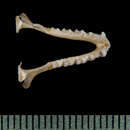Biology
provided by Arkive
Greater horseshoe bats often roost in buildings during the summer, and their presence can be detected by piles of excrement on the ground. They leave their roosts just after sunset, and during the summer, spend about an hour feeding before returning. They often feed again just before dawn. At the end of August they stay on the wing all night.Greater horseshoe bats mate in autumn, sometimes in late winter or early spring. They form maternity roosts in May and the young are born in mid-July. This species reaches maturity at around three years old and they may live for 30 years. Their preferred food is large beetles, such as cockchafers and dung beetles, large moths and caddis flies. They have been observed watching from a regular roost and then flying out to take passing insects. Greater horseshoe bats hibernate in caves, cellars or disused mines, from late September to mid-May. They may emerge to feed during mild spells.
Conservation
provided by Arkive
This species is listed in the UK Biodiversity Action Plans (UKBAPs), and has been included in English Nature's Species Recovery Programme. It belongs to a family of animals that have been much maligned over the centuries. However, more people are realising just how fascinating bats are, and they receive a high level of legal protection. The main effort in their conservation is to encourage landowners and farmers to manage their land in ways that benefit the bats. They are also being asked to limit the use of ivermectin insecticides, commonly used for treating cattle. The chemical in the insecticide also poisons the cattle's dung, and kills the larvae of dung beetles, one of the greater horseshoe bat's principal foods. As more people learn about bats, it is hoped that the efforts to conserve them as a breeding species will gain more support. They are an intriguing group of mammals, and undeserving of their sinister reputation. The Bat Conservation Trust carries out work on surveys and monitoring, and employs many volunteers.
Description
provided by Arkive
The greater horseshoe bat is the larger of the two horseshoe bats found in Britain. They are so-named from the horseshoe shaped nose 'leaf', used as part of the bat's echolocation system. The ears are leaf-shaped and have a sharply pointed tip. The fur is thick, and coloured ash-grey above, and buff underneath. Bats are not blind as was once popularly thought. They have good eyesight but rely on their echolocation to navigate and to detect their insect prey. They emit a succession of high-pitched squeaks and judge their position and the location of their prey from the reflected echoes.
Habitat
provided by Arkive
The greater horseshoe bat prefers traditionally managed farmland, with grazing pasture and broad-leaved woodland.
Range
provided by Arkive
This bat is found in central and southern Europe but has declined significantly in northern Europe. In the UK it is restricted to southern England and South Wales.
Status
provided by Arkive
Classified as Endangered in the UK, listed under Appendix II of the Bonn Convention, Appendix II of the Berne Convention, Annexes II and IV of the EC Habitats Directive, Schedule 2 of the Conservation Regulations 1994 and protected in the UK under Schedule 5 of the Wildlife and Countryside Act (as amended).
Threats
provided by Arkive
The greater horseshoe bat has declined by over 90% in numbers during the last 100 years. This is due largely to habitat loss, caused by modern intensive farming methods. The destruction of woods, roosting sites, old pastureland, and the use of chemical insecticides, which have seriously reduced the abundance of their insect prey, have all contributed to this decline.

